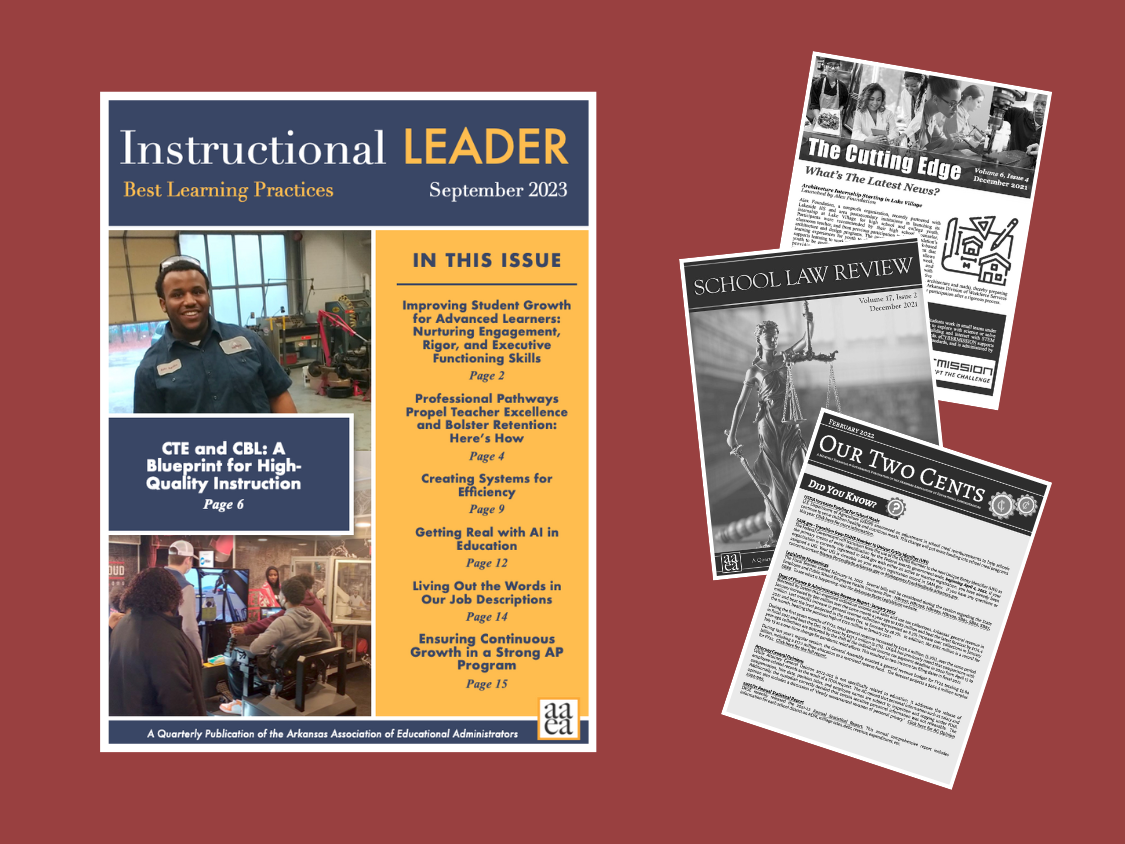
5 minute read
Publication Sneak Peek
Instructional Leader
This segment features content from other AAEA publications. Instructional Leader is a quarterly publication available to subscribing districts. The following excerpt comes from the September 2024 issue.
The Robots Are Here! Now What?
Contributor: John Ashworth, Executive Director and Superintendent, Virtual Arkansas

In November 2015, some colleagues and I attended the iNACOL (now the Aurora Institute) conference. I love high-level national conferences primarily because of the networking opportunities and the chance to see the innovative educational models and practices going on all over the nation. It is not uncommon at these conferences to meet or hear someone who has great insight into the future of teaching and learning. It was at this conference that I heard such a person. She was a seasoned and wise educator. The 45 or so years of educational experience came through in her talk. I don’t recall everything that was said, but the crux of her session was that sometime soon technology would have the opportunity to truly transform education. Then came those four words that grabbed our attention and made us laugh. She scanned the room, locking eyes with each of us, before boldly proclaiming, "The robots are coming!"
Her antics and words did their job! She created laughter, wonder, and discussion among the attendees. Some even turned the phrase into a meme to capture the moment. I have often thought of those words since AI, like ChatGPT, burst into the public consciousness in November 2022. In less than two years, this technology has evolved at a breakneck pace, outstripping what we once thought only humans could do. With the rapid advancement of AI, the current capabilities of AI, and envisioning the near-term possibilities of AI, it doesn’t take a prophet to see the massive positive potential artificial intelligence has for education and, more importantly, the students we serve.
The key word above is “potential.” AI’s capabilities are no longer in question; we all recognize them. The real challenge now is transforming that potential into reality. I believe the answer to the question of how we meet that challenge lies in all of us. Realizing the full benefits of AI for our students requires not just planning but urgent, coordinated action from all of us—educators, leaders, and policymakers alike. As Todd Whitaker quipped many years ago in his book, What Great Teachers Do Differently, it’s people, not programs, that ultimately lead to significant gains and improvements. I argue that the degree to which artificial intelligence will positively impact the education sector is not dependent upon the capabilities of AI, but the coordinated implementation efforts of educators, education leaders, legislators, technology staff, and many others. Without these concerted efforts, we risk dooming artificial intelligence as just another shiny new toy and leaving us to ponder, “What could have been?”
I do not discount the potential dangers and pitfalls of the use of artificial intelligence. Most great advancements and opportunities have risks when implemented without deliberation and fidelity. This is why several states have recently published AI in education toolkits, guidelines, and policies. I have no doubt Arkansas will put out resources of its own for educators very soon. These resources serve as guidance for educators on the implementation of artificial intelligence, but also as guardrails to help ensure the safety and security of educators and students as they are engaging with AI. In a recent op-ed by Representative French Hill, he highlighted that “TeachAI” argues that “AI guidelines can empower schools to harness AI’s potential benefits while ensuring student privacy and responsible usage.” Safety, security, and privacy concerns must be at the foundation as we enter this new AI era.
So now what? Now is the time to engage in local, state, and national discussions and planning so that every school can realize the potential of artificial intelligence for the benefit of all students. If we are truly engaged in the process, it will necessarily lead to massive change in the way we do education over time, a change that few would say is not needed. If you’ve ever been to one of my sessions, you have heard me quote retired Lt. General Stanley Clarke III, former Director of the Air National Guard. I was able to attend a speech he gave in 2014, and his words had a massive impact on my life. He said, “If you don’t stay ahead of change, not just keep up with it, you will find yourself insignificant as an individual or organization.” The robots aren't just coming—they're already here. AI-driven change is inevitable. I challenge each of you: Lead the charge, embrace innovation, and don't just keep up with change—stay ahead of it.
John Ashworth is the Executive Director and Superintendent of Virtual Arkansas. Over the last two years, he has delivered many professional learning sessions on Artificial Intelligence at districts and conferences throughout Arkansas and several national conferences.
In collaboration with Michigan Virtual and the Virtual Learning Leadership Alliance (VLLA), Virtual Arkansas has published the Planning Guide for AI: A Framework for School Districts. This guide highlights key planning considerations and provides a roadmap for starting the AI conversation in your district. Other AI resources have been posted by Dr. Robin Finley, CEO of Arkansas-based “TeachingTIME” and “TasselTIME”.

Interested in more from Instructional Leader? Contact our office at 501-372-1691.








